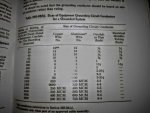emt as ground
emt as ground
thanks for the comments as usual.
emt as ground
Seen many from the time period you mentioned with poorly supported raceway contributing to broken fittings resulting in loss of EGC, also seen loose set screws or compression nuts, but that is all workmanship issues more than anything IMO. Have seen poorly made up EGC's in cable wiring methods as well - open continuity is still open continuity.
I do a lot of grain storage bins and handling equipment. Generally all steel structures and equipment. I do run EGC's in flexible conduits or in any non metallic raceways (which is usually just underground raceways in these applications) but see running any wire EGC in most of said systems as pointless, the equipment/structures are very effective fault return path, and usually more effective than my raceways, so if a fitting didn't get tightened it doesn't really matter much from equipment grounding perspective.
thanks for the comments as usual.


